- What is Agile?
- Agile Manifesto
- Value Stream Management
- DevOps
- Overview
- Jira and Confluence sprint refinement
- How to do scrum with Jira
- Learn kanban with Jira
- Learn how to use Epics in Jira
- Learn how to create an agile board in Jira
- Learn how to use sprints in Jira
- Learn Versions with Jira
- Learn Issues with Jira
- Learn burndown charts with Jira
- Auto-create sub-tasks and update fields in Jira
- How to automatically assign issues with Jira Automation
- How to sync epics stories with Jira Automation
- Automatically escalate overdue issues in Jira
- All articles
Learn to use epics in Jira
A guide on how to use and create epics in Jira

Create epics for free in Jira
Jira Epics Tutorial
This tutorial will explain how to use epics in agile software development with Jira. It will focus on epics in company-managed and team-managed spaces.
TIME
10 minute read. Complete over 2 weeks or more
AUDIENCE
You are new to agile software development or Jira
PREREQUISITE
You have created a Jira account, and a Jira space (Scrum or Kanban)
When should I create an epic?
Consider creating an epic if you have a large body of work that needs to be completed over several sprints or over a long period of time. You can also create an epic when you notice a pattern among several user stories, and you want to bundle them into one group. Check out our guide on Epics to learn about examples and templates.
Working with epics in company-managed spaces
Step 1: Create a new epic in Jira
There are three ways to create epics in Jira: the Timeline, Backlog, and Global Create button. When you create an epic, you'll need to enter the following details:
Epic name - A short identifier for your epic. This will be used as a label on work items that belong to this epic.
Epic summary - You'll see this whenever Jira displays the epic.
Create an epic on the Timeline
The timeline view is useful for visualizing and planning large pieces of work that may be in progress right now or you may prioritize in the future.
First, enable the timeline view.
From your board select More (•••) in the top right corner > Board settings
In the Timeline tab, enable the feature for your space.
Then, select Timeline from the menu on the far left.
Hit + Create epic on the Timeline. If your Timeline is empty, simply start typing to create your first epic.

Pro tip: You can also create a new epic by hovering between epics on the timeline. Learn more about the timeline view in Jira.
Create an epic from a new work item
You can create epics and any other work types using the global navigation menu.
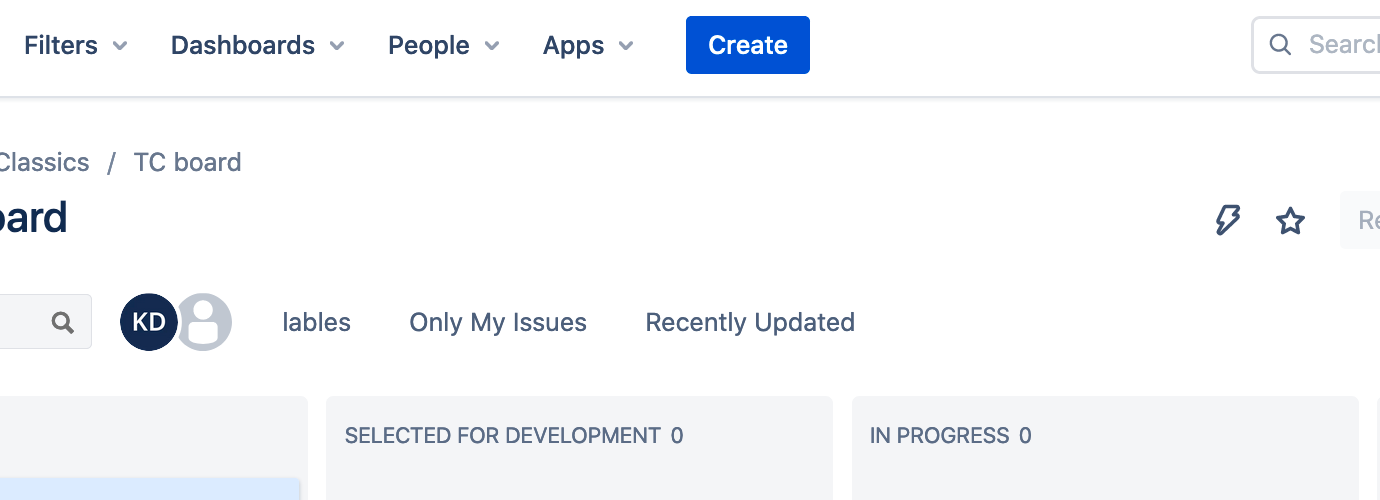
Click the create button located in the global navigation bar at the top of the screen.
Select Epic for the work item type.
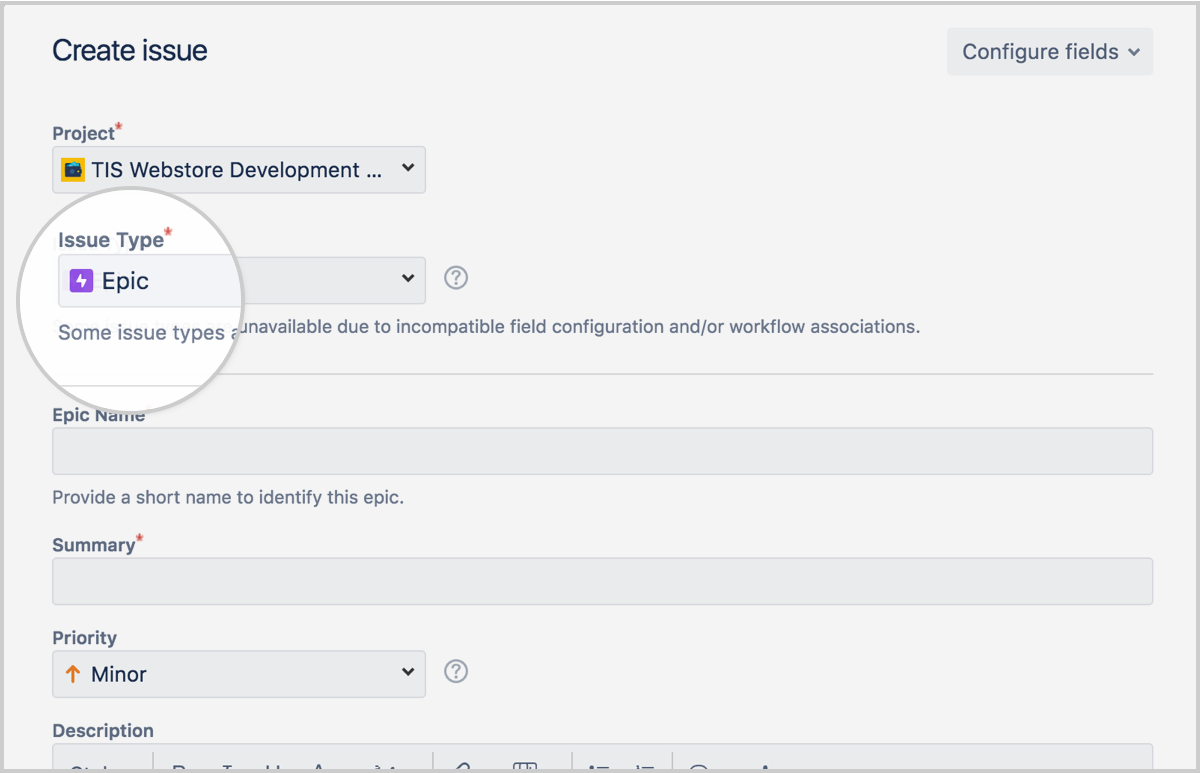
Create an epic from the Epic Panel in the backlog

1. Navigate to the Backlog.
2. Click on the Epics Panel.
3. Hit Create Epic.

Step 2: Add stories or child-work types
When you've created an epic, you'll need to add stories or child-work types to it.
What's the difference between epics and other work types?
Stories, bugs, and tasks describe a single piece of work, while epics are used to describe a group of work items that all relate to the same, larger body of work. Epics are typically completed over several sprints, or a longer time frame if you don't use sprints. Check out our guide on delivery vehicles to learn how agile teams gracefully manage scope and structure work. You can also reference the guide to working with work items in Jira.
There are two ways to add a story to an epic:
From the work create screen
Click Create in the top-right corner. Slect a work type other than epic. Find the Epic Link field, and select your epic. Fill in any other details and click Create.

From the Epics Panel
Navigate to the Backlog.
Open the Epics Panel.
Hit Create work in epic.
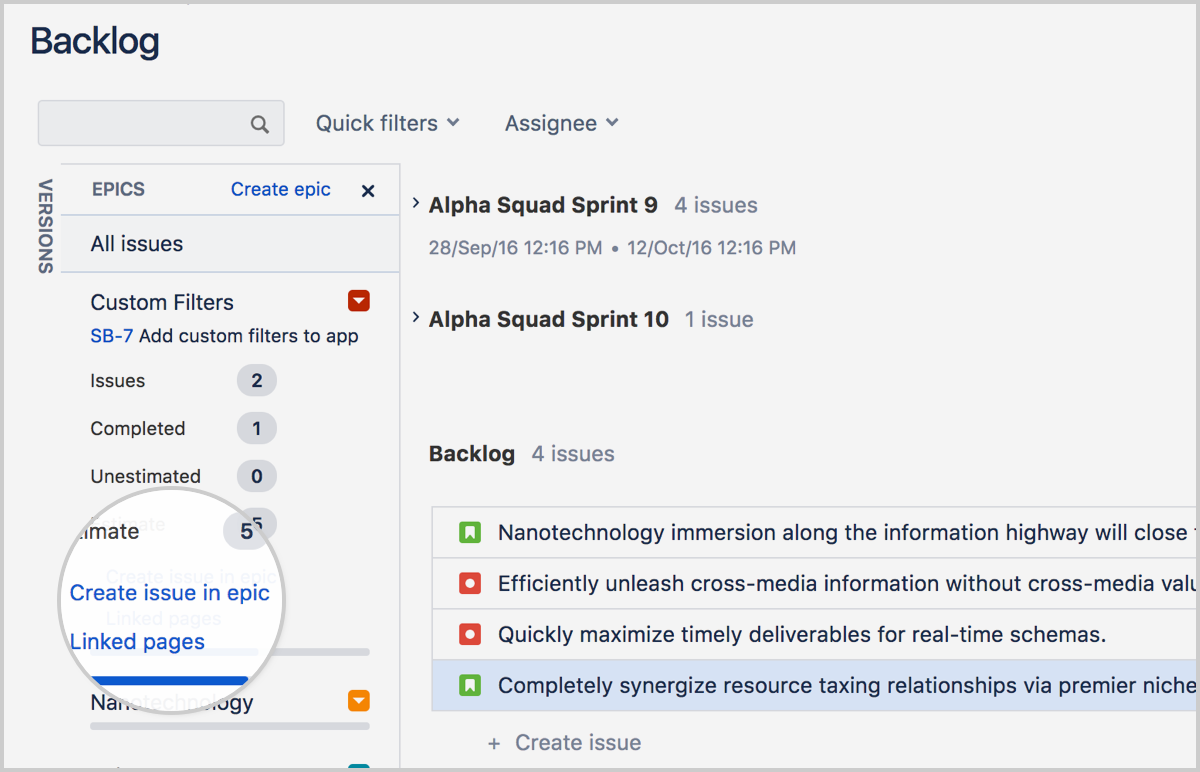
On the timeline
Hover over an epic and click + Create work item.
Choose an work type, then hit enter.
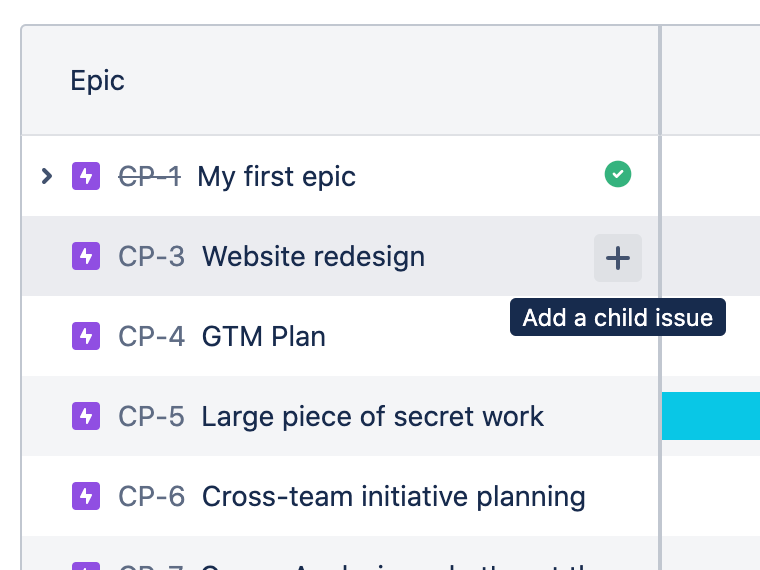
To remove a work item from an epic
Navigate to either Backlog or Active sprints:
In the Backlog, drag the work item onto the Work without epics section at the bottom of the Epics Panel; or
In either the Backlog or the Active sprints, click the relevant work item to display it on the right-hand side of the screen, then click the x in the epic name (e.g. "Apples" in Screenshot 1 below).
Step 3: Viewing your epics
You can see information relating to all your epics in the Backlog.
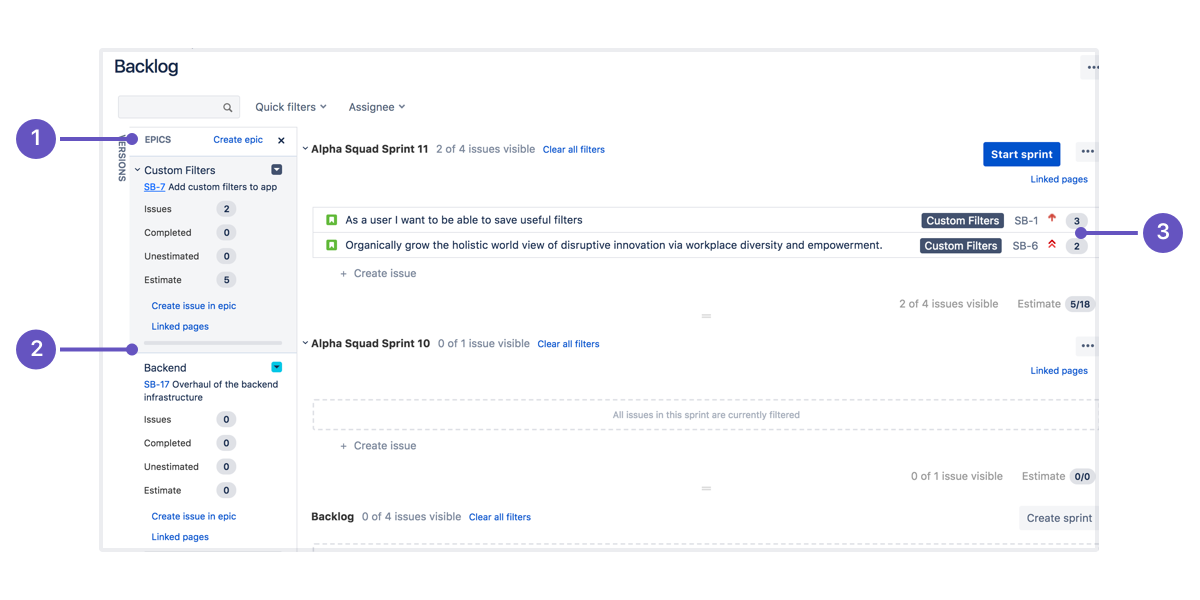
Epics Panel: Go to the Backlog and open the Epics Panel to view and manage your epics.
List of epics: The Epics Panel displays a list of all epics in your space.
View work in epic: Click an epic's name to view all the work belonging to that epic, across all sprints.
You can also view related work in an epic to see a list of the stories it contains

Step 4: Set up swimlanes for your epics on your board
During a sprint, you might find it useful to divide your board into swimlanes for each epic, to make the board visually clearer.
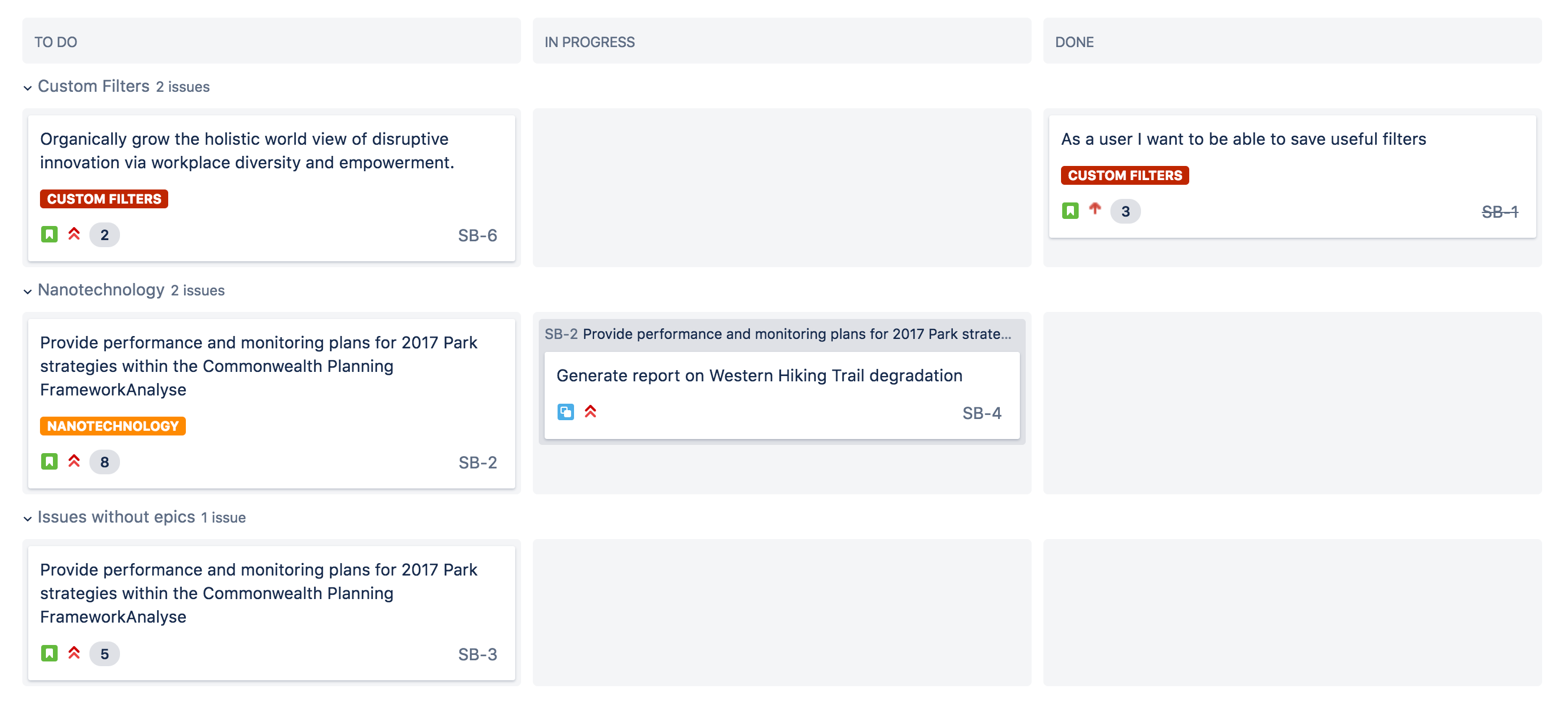
Here's how you can set this up in Jira:
Navigate to the Backlog (or active sprint).
Select more (...) > Board settings.
Click on Swimlanes.
Under Base swimlanes on, select Epics.
When you start a sprint, your board will show work items grouped under their respective epics.
Step 5: Monitor the progress of your epic
You may find it important to keep track of all incomplete work items attached to an epic. For example, if you have an epic that will span multiple sprints, you might find it useful to track the amount of work remaining over time so you can estimate when the epic will be completed.
In Jira, you can use the Epic Report to easily obtain this information.
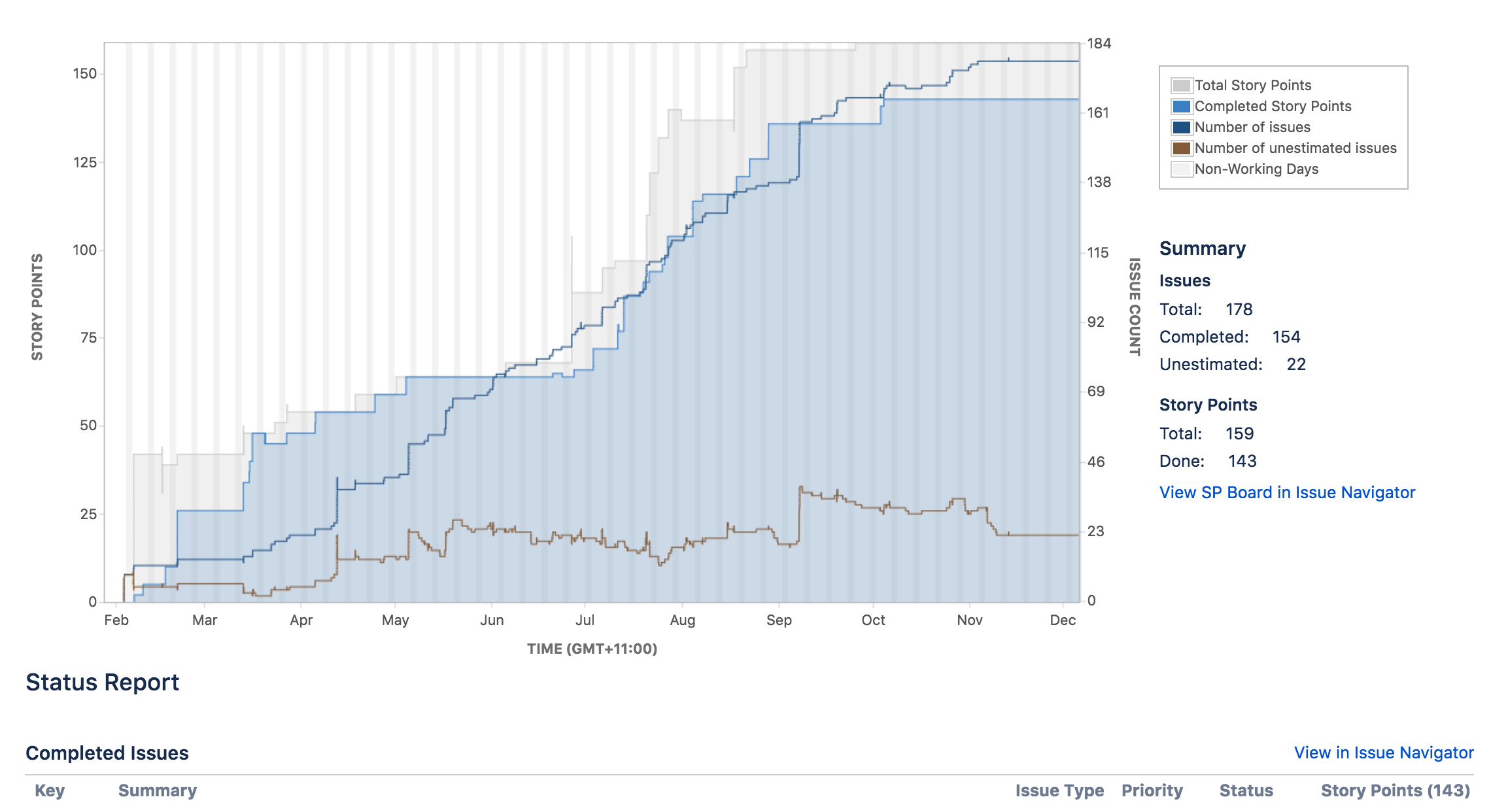
Step 6: Complete your epic
To complete an epic navigate to the backlog or timeline.
Backlog
Navigate to the Backlog.
Open the Epics Panel.
Click the drop-down for your epic, and select Mark as Done.
Using automation with epics
Automation is a great way to ensure your epics, stories, and sub-tasks always stay in sync. See one of the most common use cases in the Jira automation template library.
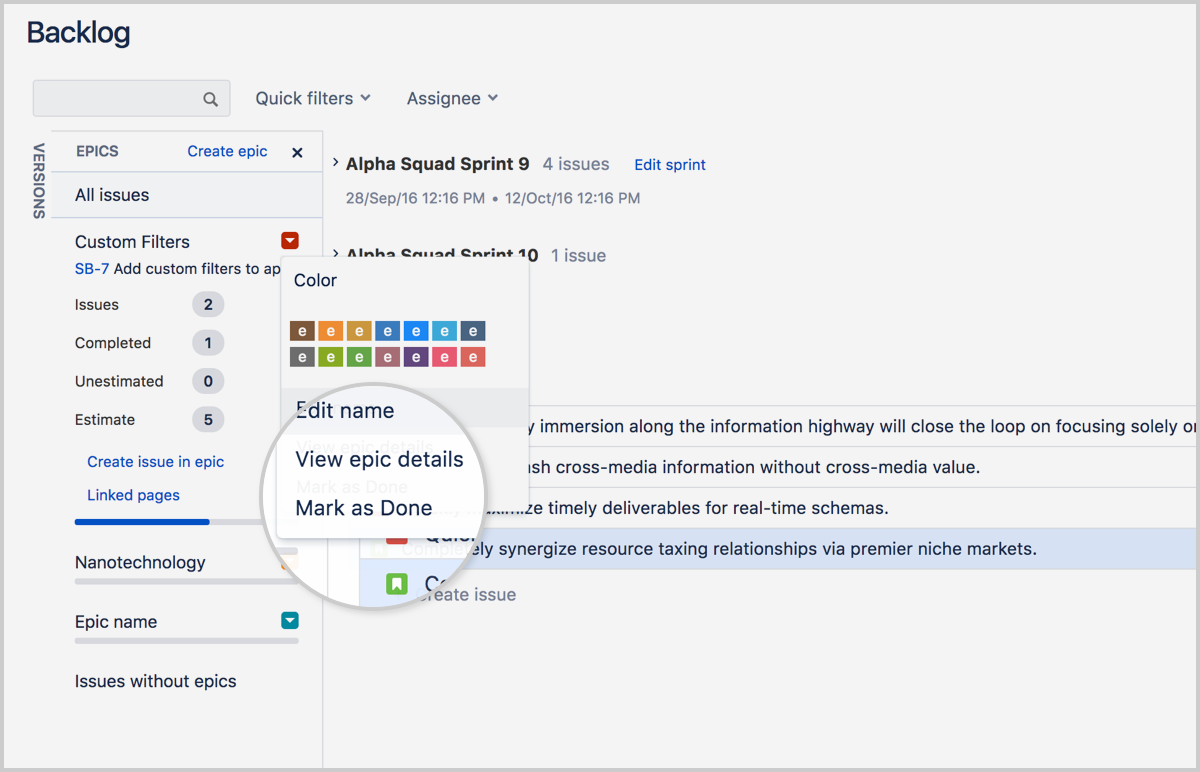
Timeline
Navigate to the Timeline
Click on the epic
Click the status drop-down in the detail view and select Mark as Done.
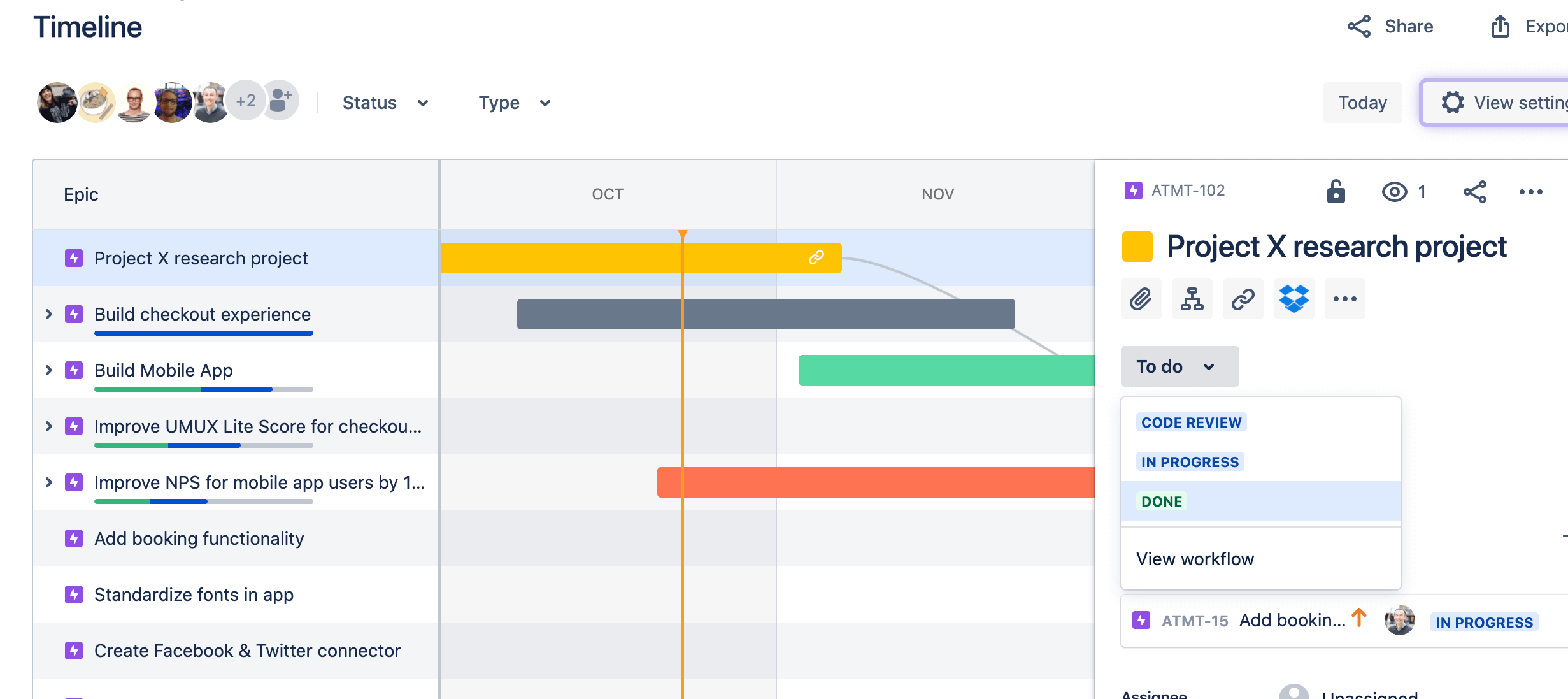
When should I mark an epic as done?
Mark your epic as done whenever all work for the epic is complete. To make this easier, we recommend coming up with a clear definition of done for your epic. Any stories linked to the epic don't have to be complete to mark an epic as done.
Want to learn more?
For more detailed information on working with sprints in Jira, check out our sprints tutorial.
Have questions? Ask the Atlassian Community.
Working with epics in team-managed spaces
The Timeline is a place where you can create, manage, and visualize your team's epics. The timeline view is useful for planning large pieces of work several months in advance and to bundle together similar stories across different sprints.
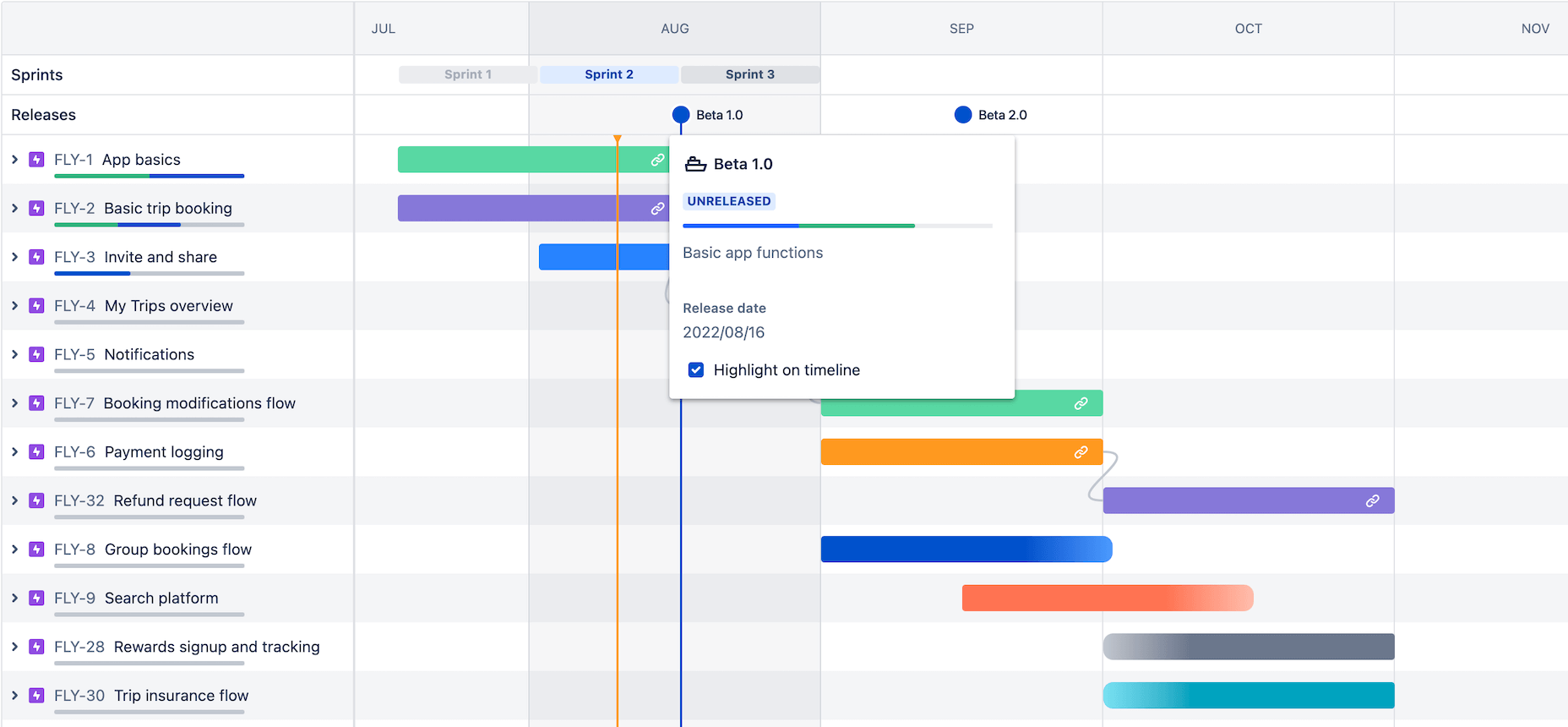
Step 1: Create a new epic in Jira
There are three ways to create epics in Jira, from the Timeline, Backlog, and using the Global Create button. When you create an epic, you'll need to enter the following details:
Epic name - A short identifier for your epic. This will be used as a label on work items that belong to this epic.
Epic summary - You'll see this whenever Jira displays the epic.
Create epics on the Timeline
Epics are created and managed on the Timeline. The Timeline is useful for visualizing and planning large pieces of work that may be in progress right now or you may prioritize in the future.
In the space menu, select Timeline.
Hit the + in the first column to create an epic. If your timeline is empty, you can just start typing to create your first epic.
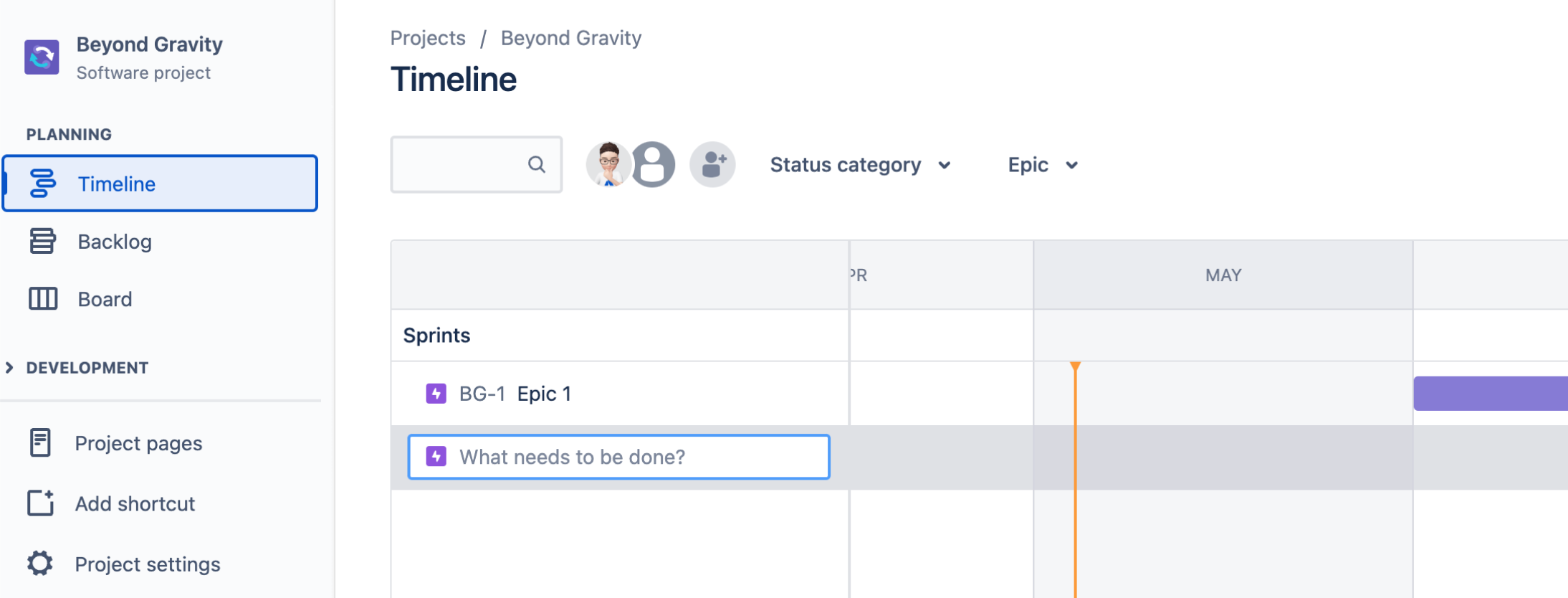
Create an epic from a new work item
You can create epics and any other work types from any screen using the global navigation menu. If you create an epic from your board view that epic will only display on your timeline or backlog.

Click the create button located in the global navigation bar at the top of the screen.
Select Epic for the work item type.

Create an epic from the Epics Panel in the backlog
To use a backlog for kanban toggle on your backlog feature in the board settings. See Enabling the Kanban backlog for more information.
Navigate to the Backlog.
Click on the Epics Panel.
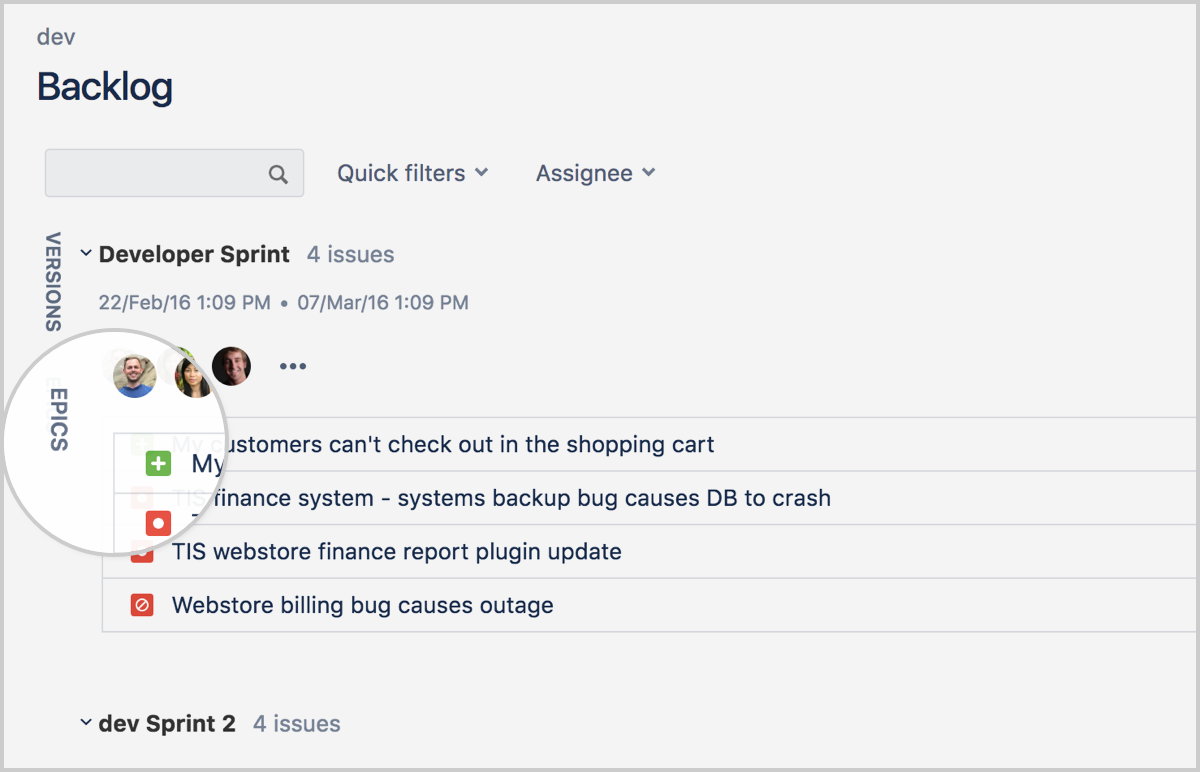
3. Hit Create Epic.
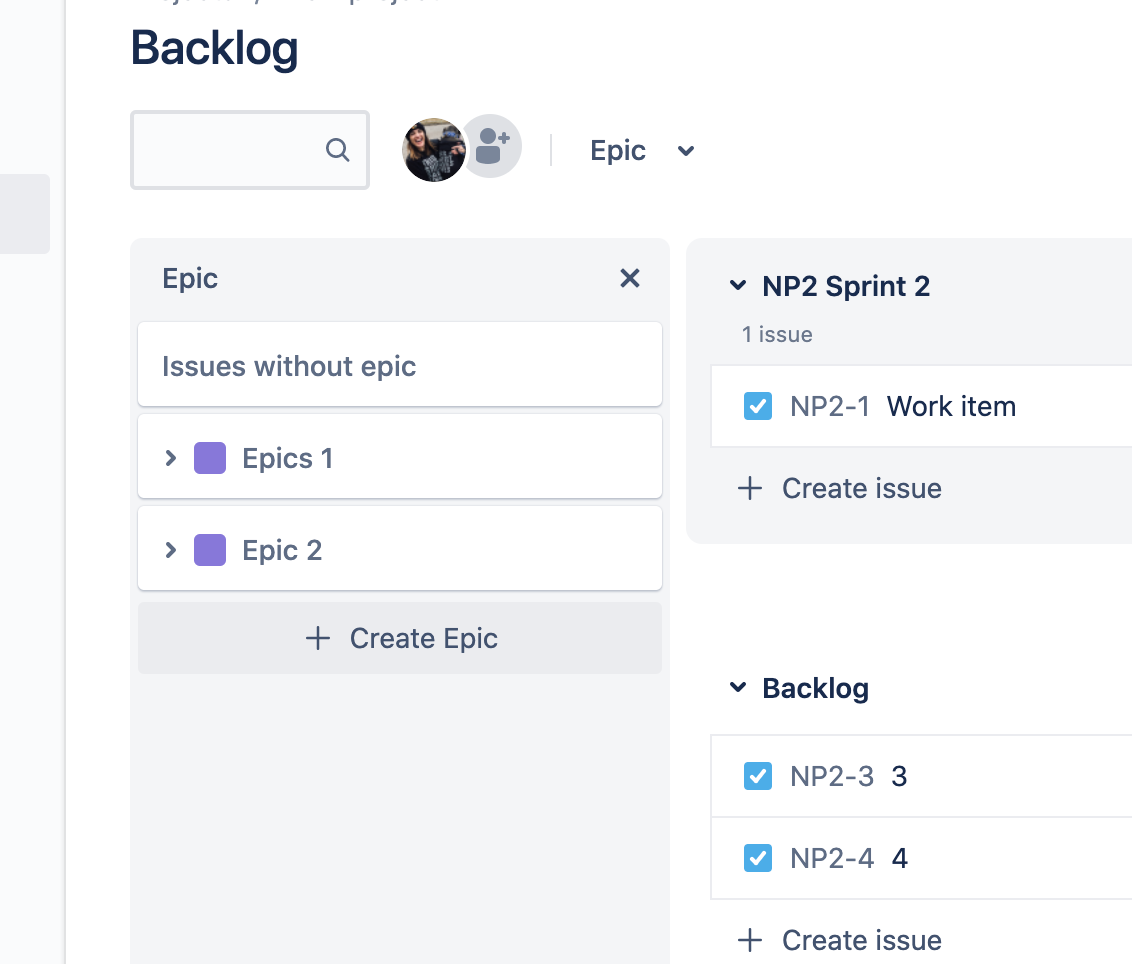
Step 2: Modify start and due dates
From the Timeline, drag the edges of the epic bar to modify the start and due dates. You can also edit these dates by clicking an epic in the Timeline or Backlog. While setting start and due dates isn’t required, we recommend you do to help with long-term planning.

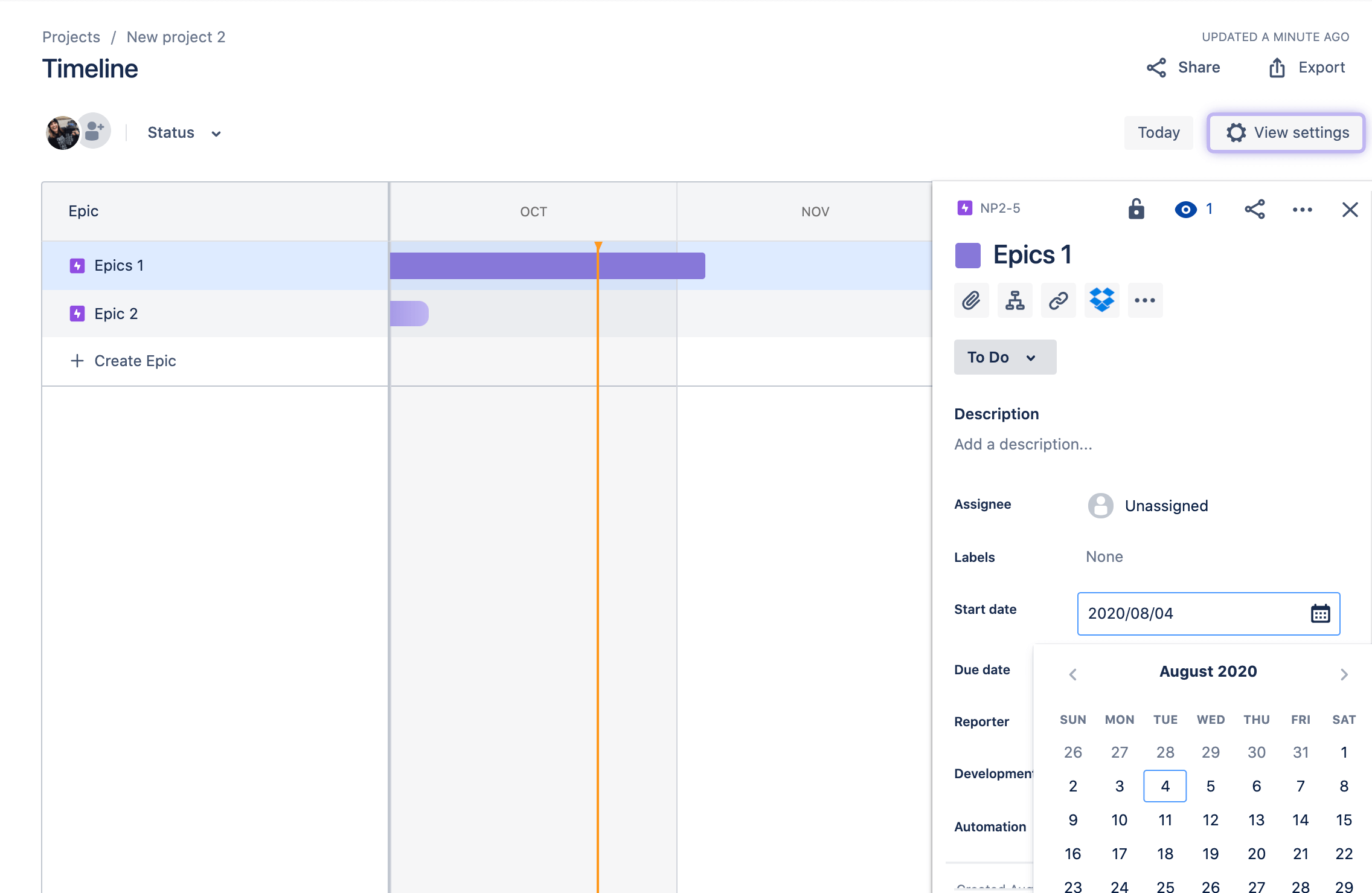
Step 3: Add child work items
You can add new child work to an epic directly from the Timeline, Backlog, or Board within the work item details.
What's the difference between epics and other work types?
Stories, bugs, and tasks describe a single piece of work, while epics are used to describe a group of work items that all relate to the same, larger body of work. Epics are typically completed over several sprints, or a longer time frame if you don't use sprints. Check out our guide on delivery vehicles to learn how agile teams gracefully manage scope and structure work. You can also reference the guide to working with work items in Jira.
On the Timeline
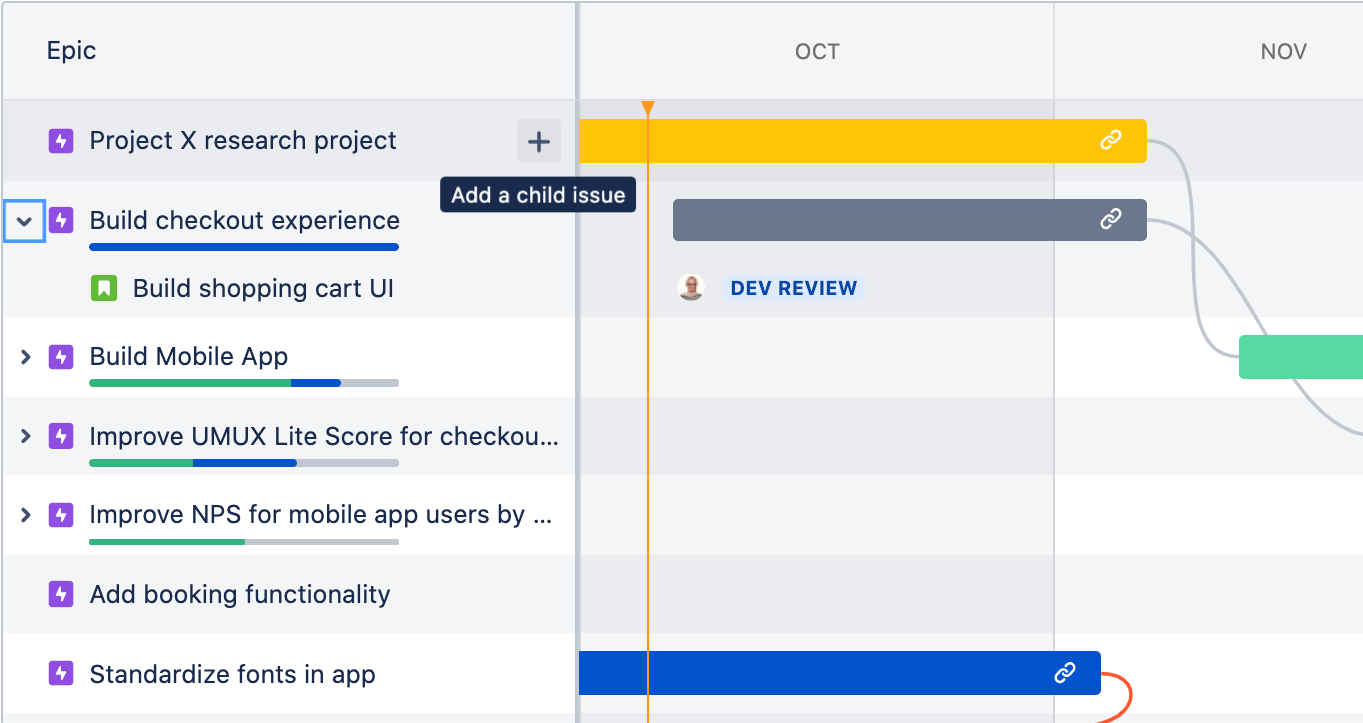
Hover over an epic and click + Create work item.
Click the arrow to select the work type. Hit enter to create the child work.
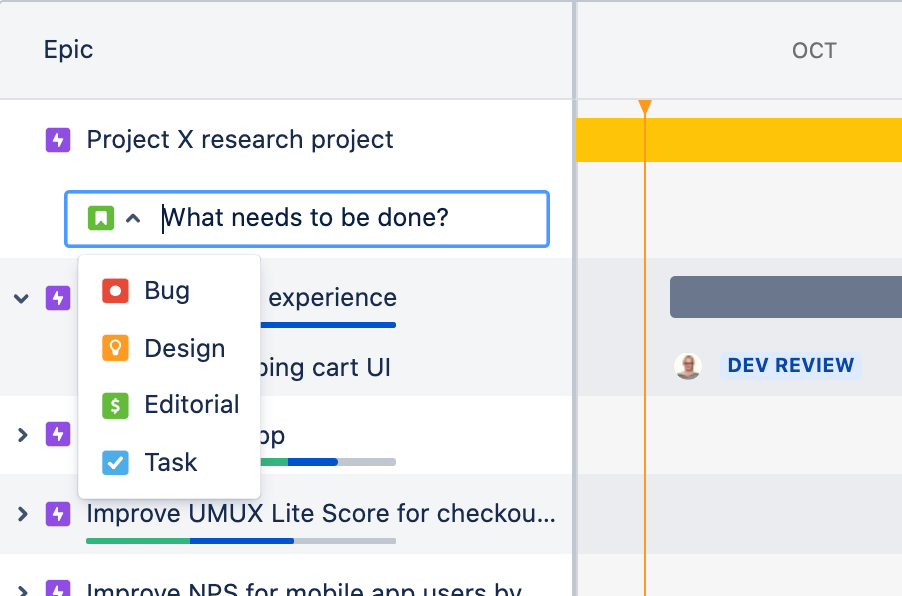
Board and backlog
Navigate to your Board or Backlog to add work to epics
Hover over a work item, and select more (•••).
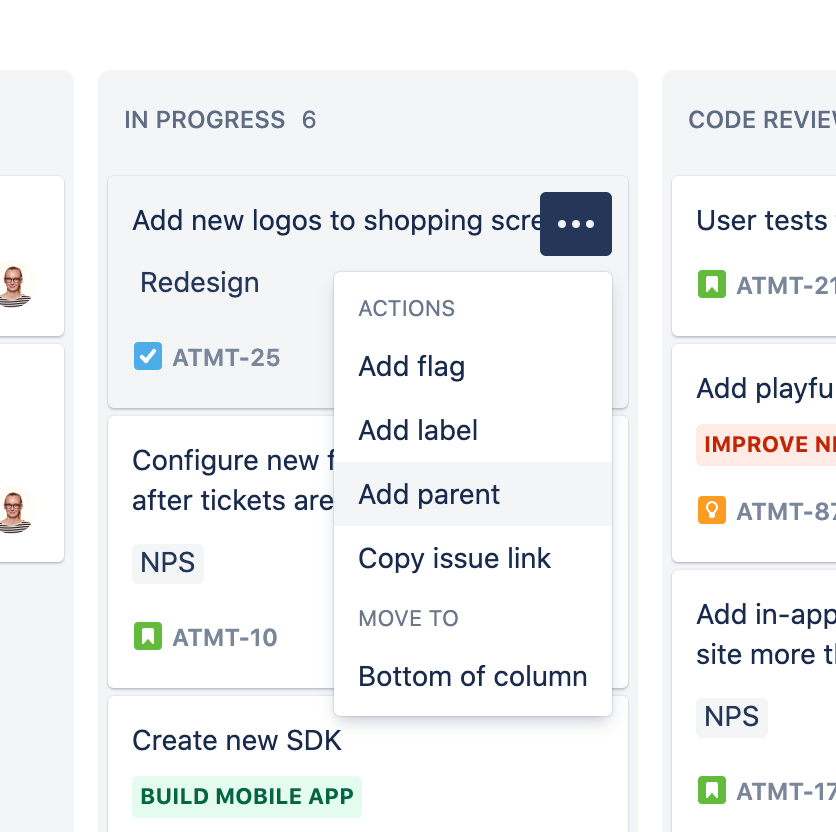
On the Board
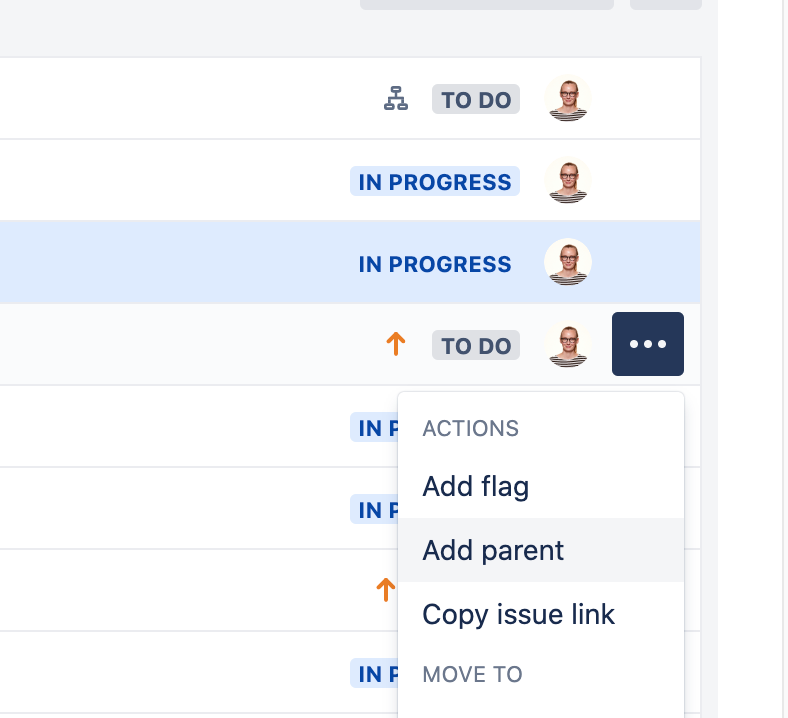
On the Backlog
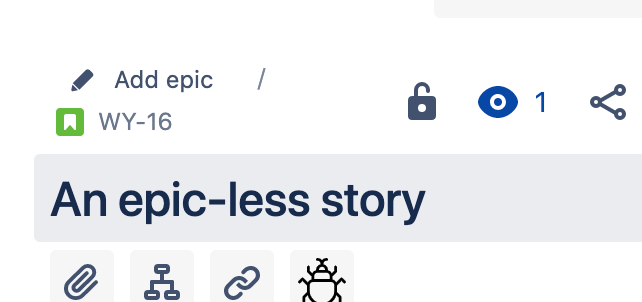
In work item detail view from board or backlog
Pro tip: You can select multiple work items with Command + Click on Mac or Ctrl + Click on Windows, and add them all to an epic at the same time.
Step 4: View an epic's details
You can view an epic's details, like start date, due date, and child work items by selecting the epic in the timeline or backlog.
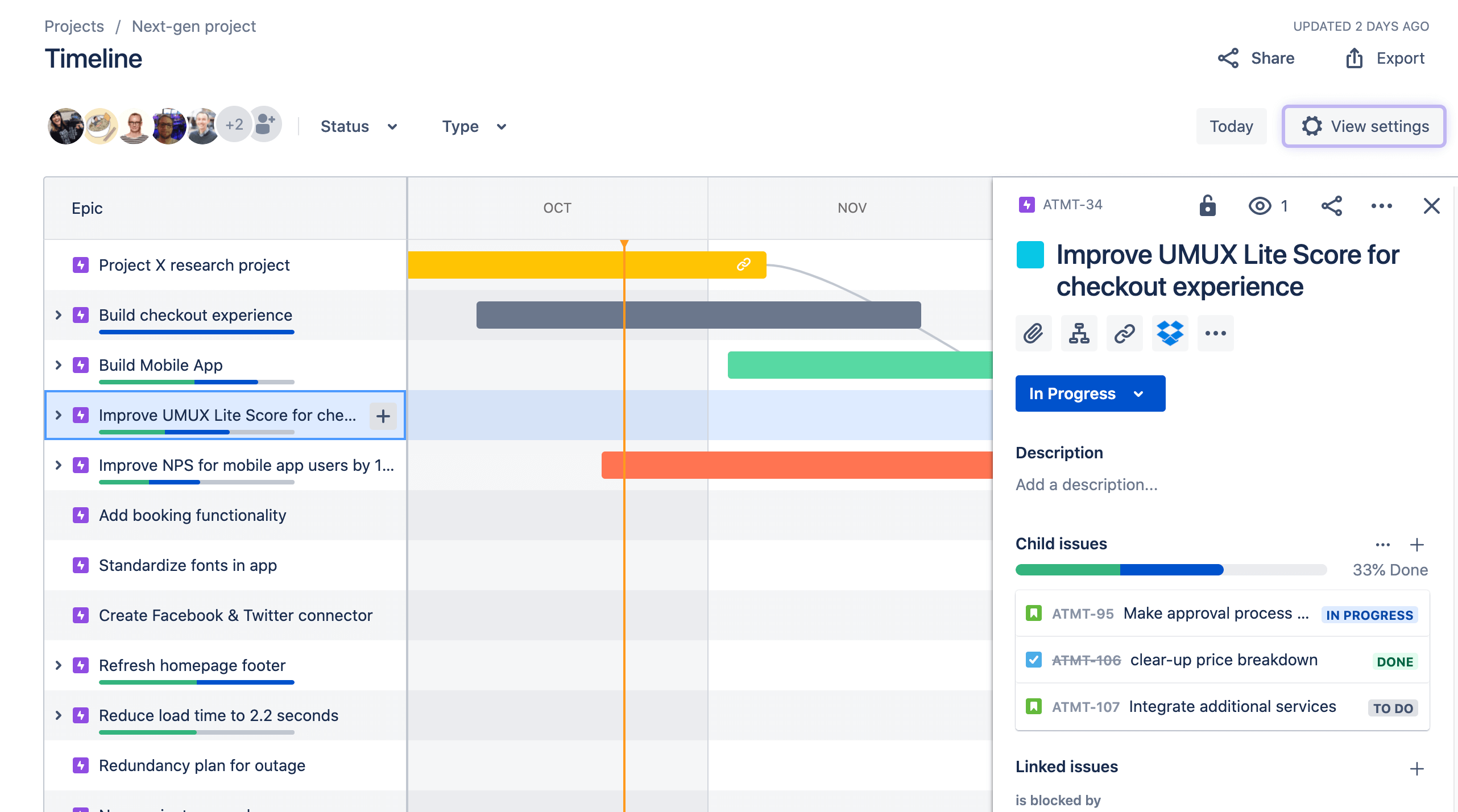
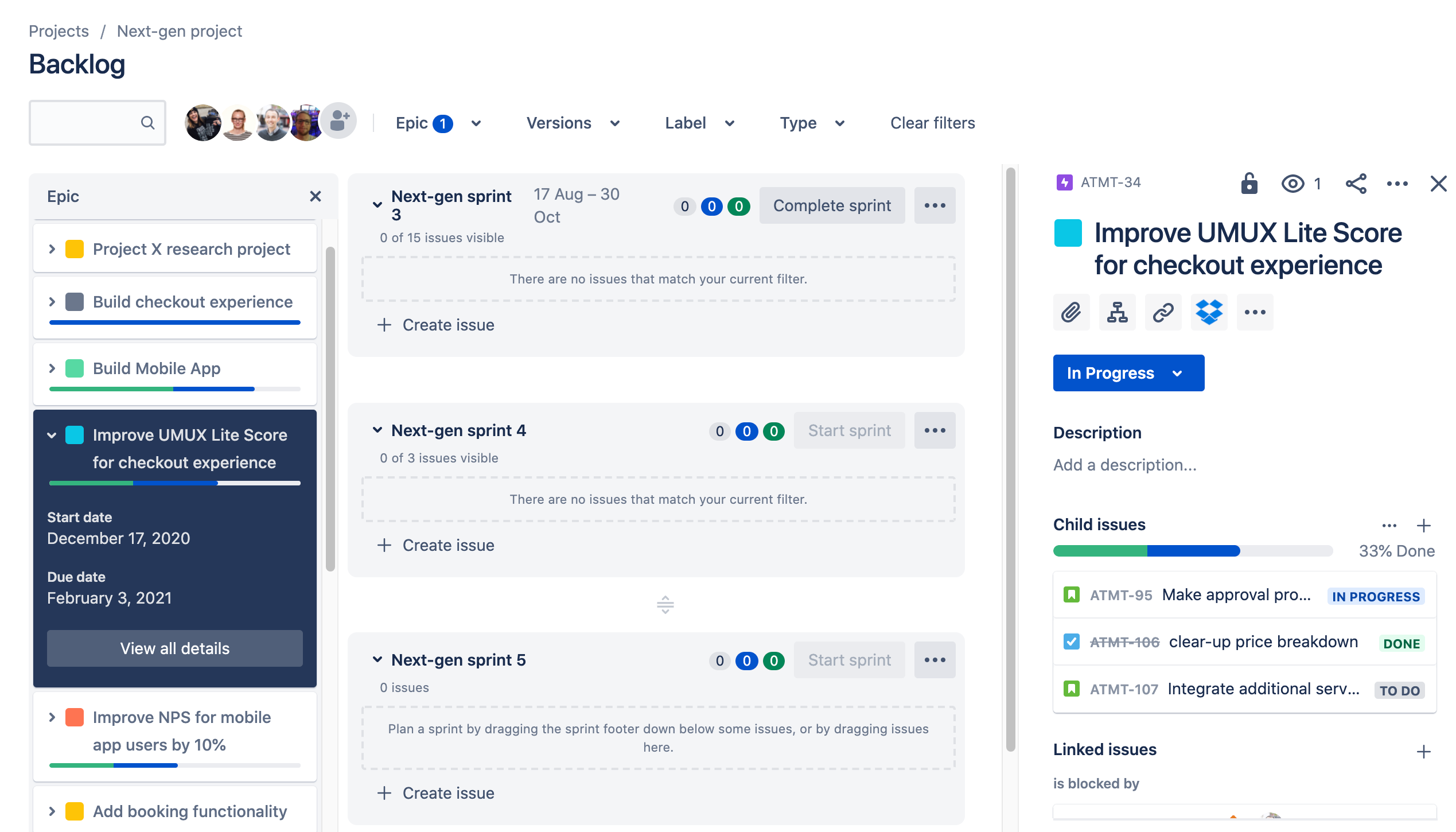
Step 5: Set up swimlanes for your epics
During a sprint, you might find it useful to divide your board into swimlanes for each epic, to easily visualize your progress. To set this up in your team-managed space:
Navigate to your board.
In the top-right corner, select the Group by menu.
Select Epic.
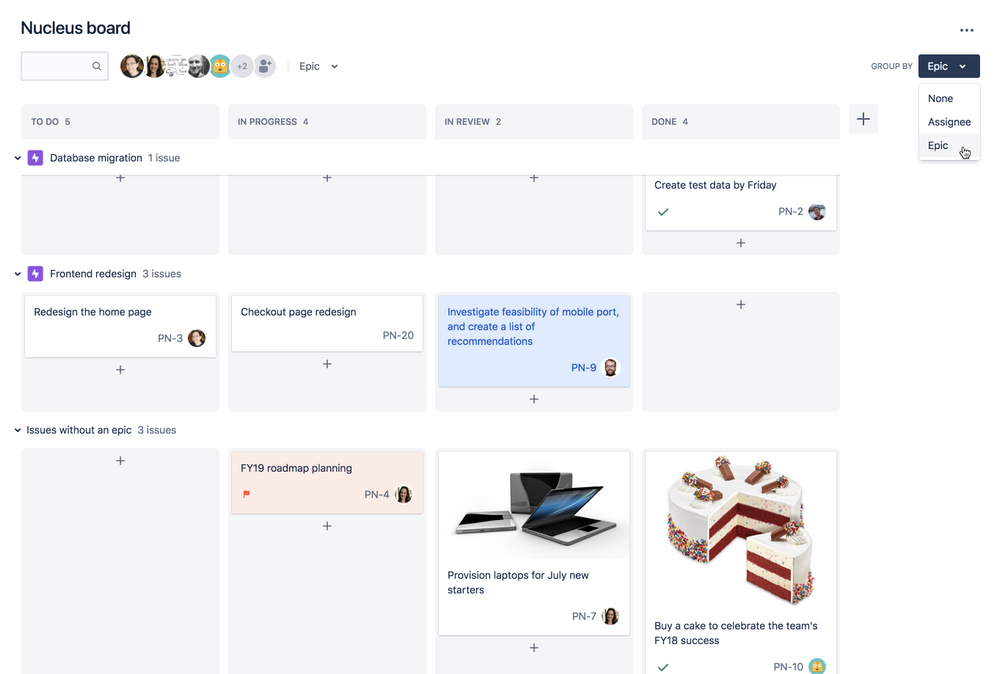
Pro tip: You can create work under an epic swimlane to quickly add a new work item to an epic. This also works if you've selected an epic in your filter.
Step 6: Complete your epic
Once all the work for an epic is completed, you should mark it as complete on the timeline.
To complete an epic:
Navigate to the Timeline.
Select the epic you'd like to mark as complete.
Under Status, select Done.
When should I mark an epic as done?
Mark your epic as done whenever all work for the epic is complete. To make this easier, we recommend coming up with a clear definition of done for your epic. Any stories linked to the epic don't have to be complete to mark an epic as done.

Learn more
To learn more about the timeline view, check out the Timeline documentation.
To learn more about configuring your work item types, including epics, check out our team-managed spaces documentation.
- What is Agile?
- Agile Manifesto
- Value Stream Management
- DevOps
- Overview
- Jira and Confluence sprint refinement
- How to do scrum with Jira
- Learn kanban with Jira
- Learn how to use Epics in Jira
- Learn how to create an agile board in Jira
- Learn how to use sprints in Jira
- Learn Versions with Jira
- Learn Issues with Jira
- Learn burndown charts with Jira
- Auto-create sub-tasks and update fields in Jira
- How to automatically assign issues with Jira Automation
- How to sync epics stories with Jira Automation
- Automatically escalate overdue issues in Jira
- All articles
Learn how to use Epics in Jira
A guide on how to use and create epics in Jira

Create epics for free in Jira
Jira Epics Tutorial
This tutorial will explain how to use epics in agile software development with Jira. It will focus on epics in company-managed and team-managed spaces.
TIME
10 minute read. Complete over 2 weeks or more
AUDIENCE
You are new to agile software development or Jira
PREREQUISITE
You have created a Jira account, and a Jira space (Scrum or Kanban)
When should I create an epic?
Consider creating an epic if you have a large body of work that needs to be completed over several sprints or over a long period of time. You can also create an epic when you notice a pattern among several user stories, and you want to bundle them into one group. Check out our guide on Epics to learn about examples and templates.
Working with epics in company-managed spaces
Step 1: Create a new epic in Jira
There are three ways to create epics in Jira: the Timeline, Backlog, and Global Create button. When you create an epic, you'll need to enter the following details:
Epic name - A short identifier for your epic. This will be used as a label on work items that belong to this epic.
Epic summary - You'll see this whenever Jira displays the epic.
Create an epic on the Timeline
The timeline view is useful for visualizing and planning large pieces of work that may be in progress right now or you may prioritize in the future.
First, enable the timeline view.
From your board select More (•••) in the top right corner > Board settings
In the Timeline tab, enable the feature for your space.
Then, select Timeline from the menu on the far left.
Hit + Create epic on the Timeline. If your Timeline is empty, simply start typing to create your first epic.

Pro tip: You can also create a new epic by hovering between epics on the timeline. Learn more about the timeline view in Jira.
Create an epic from a new work item
You can create epics and any other work types using the global navigation menu.

Click the create button located in the global navigation bar at the top of the screen.
Select Epic for the work item type.

Create an epic from the Epic Panel in the backlog

1. Navigate to the Backlog.
2. Click on the Epics Panel.
3. Hit Create Epic.

Step 2: Add stories or child-work types
When you've created an epic, you'll need to add stories or child-work types to it.
What's the difference between epics and other work types?
Stories, bugs, and tasks describe a single piece of work, while epics are used to describe a group of work items that all relate to the same, larger body of work. Epics are typically completed over several sprints, or a longer time frame if you don't use sprints. Check out our guide on delivery vehicles to learn how agile teams gracefully manage scope and structure work. You can also reference the guide to working with work items in Jira.
There are two ways to add a story to an epic:
From the work create screen
Click Create in the top-right corner. Slect a work type other than epic. Find the Epic Link field, and select your epic. Fill in any other details and click Create.

From the Epics Panel
Navigate to the Backlog.
Open the Epics Panel.
Hit Create work in epic.

On the timeline
Hover over an epic and click + Create work item.
Choose an work type, then hit enter.

To remove a work item from an epic
Navigate to either Backlog or Active sprints:
In the Backlog, drag the work item onto the Work without epics section at the bottom of the Epics Panel; or
In either the Backlog or the Active sprints, click the relevant work item to display it on the right-hand side of the screen, then click the x in the epic name (e.g. "Apples" in Screenshot 1 below).
Step 3: Viewing your epics
You can see information relating to all your epics in the Backlog.

Epics Panel: Go to the Backlog and open the Epics Panel to view and manage your epics.
List of epics: The Epics Panel displays a list of all epics in your space.
View work in epic: Click an epic's name to view all the work belonging to that epic, across all sprints.
You can also view related work in an epic to see a list of the stories it contains

Step 4: Set up swimlanes for your epics on your board
During a sprint, you might find it useful to divide your board into swimlanes for each epic, to make the board visually clearer.

Here's how you can set this up in Jira:
Navigate to the Backlog (or active sprint).
Select more (...) > Board settings.
Click on Swimlanes.
Under Base swimlanes on, select Epics.
When you start a sprint, your board will show work items grouped under their respective epics.
Step 5: Monitor the progress of your epic
You may find it important to keep track of all incomplete work items attached to an epic. For example, if you have an epic that will span multiple sprints, you might find it useful to track the amount of work remaining over time so you can estimate when the epic will be completed.
In Jira, you can use the Epic Report to easily obtain this information.

Step 6: Complete your epic
To complete an epic navigate to the backlog or timeline.
Backlog
Navigate to the Backlog.
Open the Epics Panel.
Click the drop-down for your epic, and select Mark as Done.
Using automation with epics
Automation is a great way to ensure your epics, stories, and sub-tasks always stay in sync. See one of the most common use cases in the Jira automation template library.

Timeline
Navigate to the Timeline
Click on the epic
Click the status drop-down in the detail view and select Mark as Done.

When should I mark an epic as done?
Mark your epic as done whenever all work for the epic is complete. To make this easier, we recommend coming up with a clear definition of done for your epic. Any stories linked to the epic don't have to be complete to mark an epic as done.
Want to learn more?
For more detailed information on working with sprints in Jira, check out our sprints tutorial.
Have questions? Ask the Atlassian Community.
Working with epics in team-managed spaces
The Timeline is a place where you can create, manage, and visualize your team's epics. The timeline view is useful for planning large pieces of work several months in advance and to bundle together similar stories across different sprints.

Step 1: Create a new epic in Jira
There are three ways to create epics in Jira, from the Timeline, Backlog, and using the Global Create button. When you create an epic, you'll need to enter the following details:
Epic name - A short identifier for your epic. This will be used as a label on work items that belong to this epic.
Epic summary - You'll see this whenever Jira displays the epic.
Create epics on the Timeline
Epics are created and managed on the Timeline. The Timeline is useful for visualizing and planning large pieces of work that may be in progress right now or you may prioritize in the future.
In the space menu, select Timeline.
Hit the + in the first column to create an epic. If your timeline is empty, you can just start typing to create your first epic.

Create an epic from a new work item
You can create epics and any other work types from any screen using the global navigation menu. If you create an epic from your board view that epic will only display on your timeline or backlog.

Click the create button located in the global navigation bar at the top of the screen.
Select Epic for the work item type.

Create an epic from the Epics Panel in the backlog
To use a backlog for kanban toggle on your backlog feature in the board settings. See Enabling the Kanban backlog for more information.
Navigate to the Backlog.
Click on the Epics Panel.

3. Hit Create Epic.

Step 2: Modify start and due dates
From the Timeline, drag the edges of the epic bar to modify the start and due dates. You can also edit these dates by clicking an epic in the Timeline or Backlog. While setting start and due dates isn’t required, we recommend you do to help with long-term planning.


Step 3: Add child work items
You can add new child work to an epic directly from the Timeline, Backlog, or Board within the work item details.
What's the difference between epics and other work types?
Stories, bugs, and tasks describe a single piece of work, while epics are used to describe a group of work items that all relate to the same, larger body of work. Epics are typically completed over several sprints, or a longer time frame if you don't use sprints. Check out our guide on delivery vehicles to learn how agile teams gracefully manage scope and structure work. You can also reference the guide to working with work items in Jira.
On the Timeline

Hover over an epic and click + Create work item.
Click the arrow to select the work type. Hit enter to create the child work.

Board and backlog
Navigate to your Board or Backlog to add work to epics
Hover over a work item, and select more (•••).

On the Board

On the Backlog

In work item detail view from board or backlog
Pro tip: You can select multiple work items with Command + Click on Mac or Ctrl + Click on Windows, and add them all to an epic at the same time.
Step 4: View an epic's details
You can view an epic's details, like start date, due date, and child work items by selecting the epic in the timeline or backlog.


Step 5: Set up swimlanes for your epics
During a sprint, you might find it useful to divide your board into swimlanes for each epic, to easily visualize your progress. To set this up in your team-managed space:
Navigate to your board.
In the top-right corner, select the Group by menu.
Select Epic.

Pro tip: You can create work under an epic swimlane to quickly add a new work item to an epic. This also works if you've selected an epic in your filter.
Step 6: Complete your epic
Once all the work for an epic is completed, you should mark it as complete on the timeline.
To complete an epic:
Navigate to the Timeline.
Select the epic you'd like to mark as complete.
Under Status, select Done.
When should I mark an epic as done?
Mark your epic as done whenever all work for the epic is complete. To make this easier, we recommend coming up with a clear definition of done for your epic. Any stories linked to the epic don't have to be complete to mark an epic as done.

Learn more
To learn more about the timeline view, check out the Timeline documentation.
To learn more about configuring your work item types, including epics, check out our team-managed spaces documentation.
Recommended for you
Templates
Ready-made Jira templates
Browse our library of custom Jira templates for various teams, departments, and workflows.
Product guide
A comprehensive introduction to Jira
Use this step-by-step guide to discover essential features and the best practices to maximize your productivity.
Git Guide
Understanding the Basics of Git
From beginners to advanced experts, use this guide to Git to learn the basics with helpful tutorials and tips.